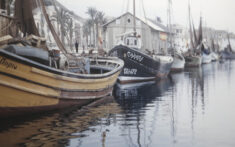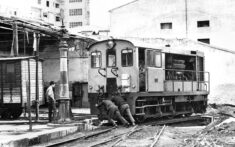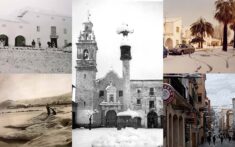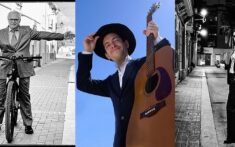One hundred years ago, a young American lover of Spain and the Mediterranean finished his studies and paid a visit to this part of the world he lived in love with. Here he was inspired, tasted the typical food and wrote. He wrote a lot: letters to his friends in the United States describing in detail his Spanish experiences, and a book of poems, A Pushcart at the Curb, in which he dedicated a few words to Denia.
The Dénia that discovered John Dos Passos had a train station with a higher floor in the main building that would be demolished few years later, between 1920 1922. The Mercat was in Glorieta, and the banana trees of Marqués de Campo began to sprout. The port was infested with local fishermen and the weeds ate the ruins of the castle.
That Denia, the one of 1917, has been portrayed in a photographic exhibition that can be visited until the next 30 of September in the vestibule of the first plant of the Municipal House of Culture. In this sample you can also see first editions in Castilian of some of his most relevant works, such as Manhattan Transfer o Rocinante returns to the road, and A Pushcart at the Curb, his only book of poems, in which we find the two that refer to Denia. This material has been acquired by the Municipal Library on the occasion of the centenary of the visit and is now exposed along with other works by the author in this exhibition, which can be visited until the 30 in September.
The exhibition is completed with a catalog with texts from the municipal archivist, Rosa Seser, Alan Swan and Francesc Reus Boyd-Swan which gathers the history of the visit and how it was the Denia of 1917, with details until now unpublished; comments on poems XVII and XVIII of A Pushcart at the Curb that speak about Dénia and its translation from English to Spanish, by Alan Swan, and biographical notes on the author written by Francesc Reus, also creator of the translation of the poems to the Valencian. The catalog will be distributed free of charge between the public of the exhibition and any interested person who requests it in the House of Culture and the Library.
This was how the exhibition was prepared
Rosa Seser, municipal archivist, debunked the details of the previous research that has been done to give birth to this sample:
Unraveling the details of the visit to Dénia, a timely event, has been a real research work done by Alan Swan and me. We start with a note from Catalina Montes' study where she cites a letter that Dos Passos sends to her friend Rumsey Marvin from Xàtiva in January of 1917.
Dos Passos was always in love with Spain and when he finished his studies in Madrid, a very traveler and a good walker, he decided to visit the Mediterranean. We have followed that visit in detail by consulting several studies and especially two publications by Towswen Ludington in the years 1973 and 1980, all in English, on letters and personal writings of Two Steps. So we got to know, I think for sure, what was your itinerary from Madrid by train in Alcazar de San Juan in Cartagena, Alicante, Denia, Oliva, Gandia ... to Tarragona. An itinerary marked by his interest in historical architecture.
Dénia arrived on Friday 5 or Saturday 6 in January, Three Kings Day and left on January 7. He leaves in third class on the train to Oliva and says of that train: "It had a slight imperial air like the trains of Paris."
Dénia describes it as "a fishing town with an old fortress overlooking the port" he must have liked a lot because in a letter dated March 21, 1917 from Italy he writes that "Except Dénia, he has not been in a place as beautiful as Positano ". It reinforces the idea that it was in the Routes.
The journey continues by train and on the cards tells the one who eats 7 on January 2017 in an inn in Oliva and looks like a stew and figatells.
Regarding poetry we have edited the Spanish and Valencian translations of the already known: "How fine to die in Dénia ...", and now the unknown: "The old Strongs towers / The strong and old towers ..." where he speaks about the half-collapsed castle, the passage of time and history, about a shepherd of goats and the music of the band that plays in the town hall square, with a note at the end that says: Dénia.
We have also included, as the only one remaining from the visit to the coast, a third poetry on the road to Villajoyosa. A road we know made on foot from Alicante, where he tells us how that road is and where it describes the landscape and the sea.
It must be said that the investigation is not yet closed and we have contacts with the American Universities of Virginia and Yale, where are the two step letters to his friends Rumsey Marvin and Dudley Poone. So some more detail can be found.
Also for the exhibition we have bought the original editions of the work of the poems: A Pushcart at the Curb (a street cart), and the first editions in Spanish of "Rocinante ride again" and Manhattan Transfer, the most famous work, which his friend Jose Robles translated. A story that we will meet with the documentary.
I want to point out that with the organized events the exhibition, the conference and the documentary we can know the figure of John Dos Passos and its evolution: from the detail of the youth visit in Dénia, we will know the writer with the conference of Manuel Vicent and the crisis personal by the friend disappeared during the Civil War in the documentary.






















